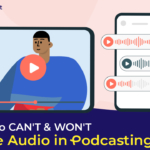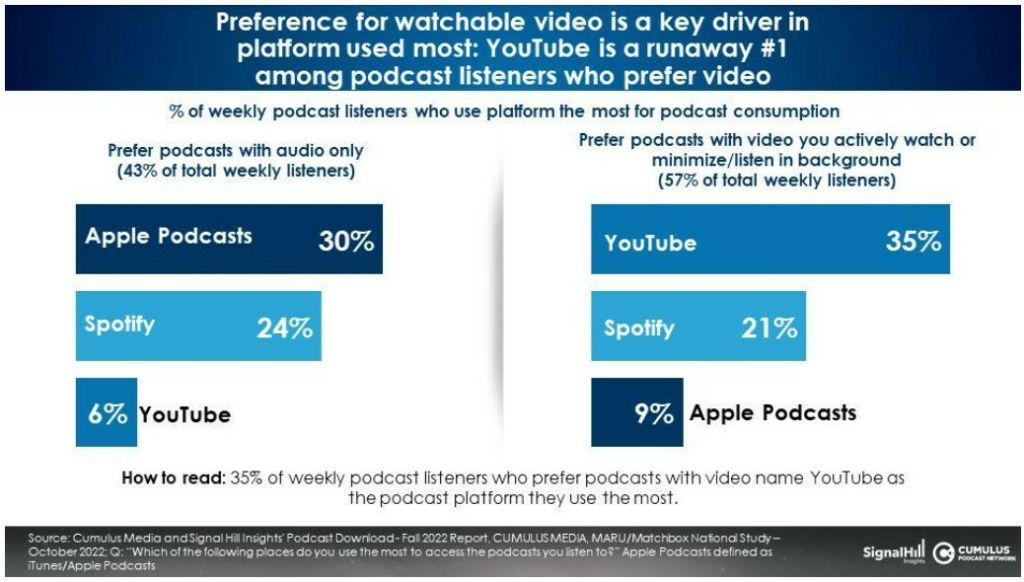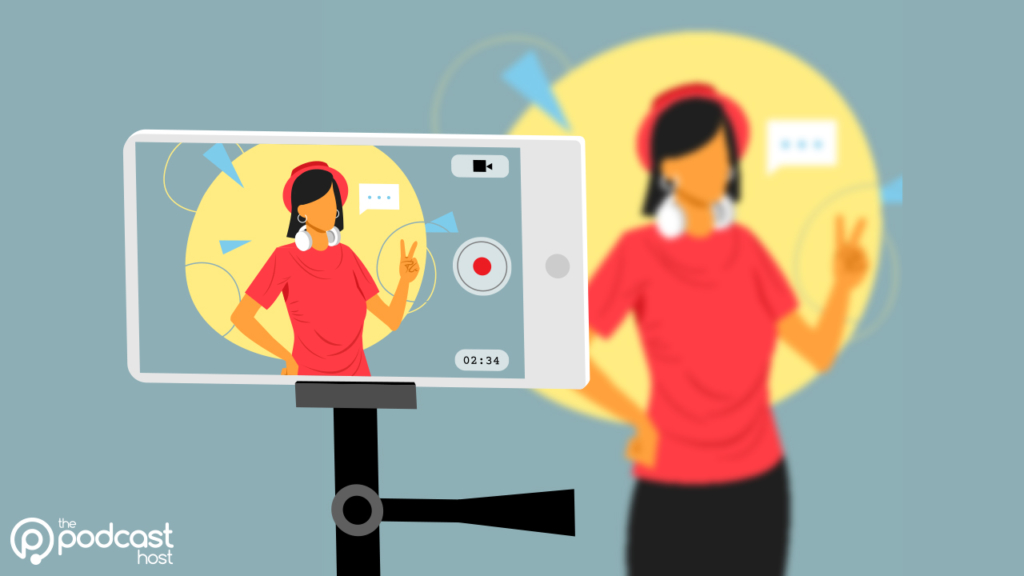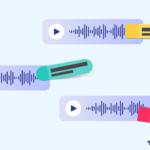Video Podcast Guide: Your Questions Answered in 2025
The definition of ‘what is a podcast?’ has become blurry in recent years. On the one hand, a TikTok influencer uploads a fifteen-second video and calls it a podcast, while on the other hand, a seasoned veteran tells you that if you don’t have an RSS feed, you don’t have a podcast.
So, does it really matter how different people define podcasts? Not always. But I suppose it can.
For example, if someone hears you have a podcast, yet they can’t find it on their listening app of choice, that will cause a bit of confusion and frustration, which will, in turn, hamper your growth.
But we’ve already contributed to the ins and outs of the “what is a podcast?” discussion with Colin’s “explanation in plain English”.
This time around, I’d like to talk specifically about video podcasts.
What exactly is a video podcast, and should you make one? And are they essentially just videos on YouTube?
Can a YouTube Video Be a Podcast?
For years, you’ve been able to find loads of videos of podcasts on YouTube (most famously, Joe Rogan!). If we want to keep in line with that technical definition of what a podcast is, then these were video recordings of podcast episodes rather than podcast episodes themselves.
But YouTube now works more like a traditional podcast consumption platform because you can add the RSS feed from your hosting account, and it’ll automatically publish all of your new episodes. This is similar to how you distribute your show to places like Apple Podcasts and Spotify.
Publishing Podcasts on YouTube
An audio podcast episode published on YouTube will appear with a static image (the show’s cover art) as its “video”.
One key difference between podcasts on YouTube and most other places is RSS feed ingestion. Again, this sounds like obscure technical minutiae, but it means that if you make edits to your published episode in your hosting account – anything from the episode title or show notes to the audio file itself – these changes will not automatically update in YouTube.
To edit a podcast on YouTube, you need to log in and repeat these changes manually. You’ll likely also need to check your YouTube stats separately – they’re often not included in your main hosting download numbers.
Creators can log into YouTube Studio to create podcasts on the platform. This works by marking a playlist as a “podcast” or by submitting your RSS feed. Some hosting providers have “distribute to YouTube” tools, which are often much more streamlined if you are an audio-only podcaster.
So, from a creator’s point of view, you can mark any of the videos in your channel as podcast episodes, and from a consumption point of view, you’ll now find dedicated “podcasts” sections on YouTube and YouTube Music.
Other Types of Video Podcasts
Podcasts are overwhelmingly done in audio, and are subscribed to or ‘followed’ in places like Apple Podcasts, Spotify, and Overcast.
Comparatively, the percentage of actual video podcasts out there is tiny. Yes, it’s now a growing wing of podcasting. But video is still dwarfed by audio.
YouTube, Apple Podcasts, and Spotify are the most popular places to find video podcasts, but some other directories also support them.
An example on Apple is Ted Talks Daily, which is a video companion to the audio-only version of the show.
Here’s a list of popular video podcasts on Spotify, too. You can now upload video podcasts to Spotify even if you don’t use them as your primary hosting provider.
So as you can see, video podcasting is very much a thing, both on and off of YouTube.
But does that mean you should make a video podcast if you’re already creating audio content?

Why Video Can’t & Won’t Replace Audio in Podcasting
Read article called: Why Video Can’t & Won’t Replace Audio in PodcastingDoes My Audio Podcast Audience Want Video Content?
Nearly a third of the podcast audience surveyed here prefers to “actively watch” a podcast with a video component.
Consumers were asked their preference for three podcast experiences:
- Audio only without any video (43% preference)
- Play video in the background or minimize on device while listening (29%)
- Actively watch while listening (28%)
This data suggests that there’s undoubtedly a demand for video podcasts. Whether or not your existing audience wants a video element might not be the primary reason for deciding to go down this route, though. Instead, new visibility and extra discoverability could be seen as the primary benefit. If some existing listeners want to transition to watching your content, then treat that as an added bonus.
Where Do People Watch Podcasts?
Some other interesting stats are included in the same Cumulus Media/Signal Hill Insights data mentioned above.

35% of weekly podcast listeners who prefer podcasts with video name YouTube as the podcast platform they use the most.
This is with Spotify in second place (21%) and Apple Podcasts third on 9%. Compare this to audio-only podcast data, and you have Apple top on 30%, Spotify second with 24%, and YouTube third with 6%.
So, if you’re going to create any sort of visual element around your podcast, then publishing on YouTube is a no-brainer.
You might choose to go above and beyond just uploading the entire episode, too. From a new visibility point of view, capturing someone’s attention with video content on YouTube for more than a few minutes is rare. Instead, you can use select clips that focus on one particular question or topic, and upload them as ‘micro-content’. This technique is explained in detail in Gavin Bell’s guide to running ads on Facebook, and in Daren Lake’s content stacking masterclass.
A lot of the debate around video podcasts (as well as content in general) is centred on what medium is “best”. But podcasting (audio), YouTube (video), and blogging (shownotes) can all complement each other sustainably and effectively. Check out our series on Content Stacking for a full guide on how to get the best from this approach.
Video Podcast Hosting Providers
First and foremost, let’s look at YouTube. As we’ve covered already, you can:
- upload content to YouTube directly and tag it as a podcast
- or, link your RSS feed to your YouTube account
- or, use your hosting provider’s “publish to YouTube” tools
If you want your video podcast to appear in Apple Podcasts, Podbean and Castos are two great hosting services that enable this. I’ve linked to our full reviews of both so you can learn more about them.
And, to create a video podcast on Spotify, you no longer need to host on Spotify for Podcasters. No matter where you publish your show, you can log into your Spotify Podcasts Portal, click the three dots on any episode, and you’ll find an ‘upload video’ option.
How to Record Video Podcast Episodes
Whether you’re doing a traditional video podcast or recording videos alongside your podcast, there is no shortage of tools to capture it all.
SquadCast, Riverside.fm, Iris, and VEED are four popular platforms for video podcasters. Veed, in particular, has some great video editing tools as well as a free tool to convert videos to audio. We dive into these video podcasting and remote recording tools in more detail in our How to Put a Podcast on YouTube article.
Editing Your Video Podcast
There’s too much competition and too little attention out there for you to upload a raw video and get any traction with it. You’ll need to do at least some editing to your video if you want it to have any hope of catching some eyeballs.
So, what video podcasting software should you use?
Fortunately, there are a lot of great options on the market, and some of the newer ones cater to complete beginners. If you’re new to video podcasting, opt for Veed. Or, consider Filmora if you’re on a very tight budget.
We also have an in-depth roundup of the best video editing software platforms where you’ll find more detail on Veed and Filmora, as well as Adobe Premiere, Final Cut Pro, and Camtasia.
Best Platform to Export Audio as Podcast Videos?
Of course, your video doesn’t always need to be “video” in the conventional sense. There are many different types of video podcasts.
Some podcasters upload videos that are static images (usually the show’s cover art) with the audio recording playing alongside it. This means you can get your show onto platforms like YouTube without much additional effort.
You can easily export video in this way if you’re using Alitu to record and edit your podcast, or, if you host with Libsyn or RedCircle.
Alternatively, you can go that extra step and create Audiograms for your podcast. These are similar to static images but can include dynamic waveforms and closed captions.
Audiograms work better for pulling short clips from an episode than for being fully-fledged episodes in their own right. Our AI Tools for Podcasters roundup has more options for creating audiograms and shareable video clips, too.

7 AI Video Repurposing Tools for Podcasters: Tested & Compared
Read article called: 7 AI Video Repurposing Tools for Podcasters: Tested & ComparedDoes Your Video Clip Thumbnail Matter?
We all know that old adage, “Don’t judge a book by its cover,” right? Well, that isn’t exactly true when it comes to video podcasting.
Crafting a great custom thumbnail for your video is essential for hooking a big portion of your views. The thumbnail is what makes viewers want to watch your video, and you should spend a good deal of time coming up with something creative.
If you don’t upload your own thumbnail, YouTube will automatically choose one for you, and this is no good. It won’t do anything to capture your audience. Do a bit of research on what your competitors are up to and get creative. You’ll improve over time and come to know what performs and what doesn’t.
If you’re looking for a free tool to make great custom thumbnails for your video podcasts, then check out Canva. There, you’ll find loads of different designs and templates!

Video Podcast Equipment List
So, if you’re looking to make a video podcast where you record yourself and your surroundings, what fancy equipment can you use to take things to the next level?
Our guide includes affiliate links. If you buy through them, we may earn a small commission (never at any extra cost to you!).
A High-Definition Camera, or, Multiple Cameras
With the quality of video on iPhones and Androids now, getting multiple cameras together to record should be easy. Many podcasts use a multi-camera approach to their video podcasts. It’s not necessary to use multiple cameras; however, it can make your videos look much more dynamic.
One option here to consider is the Logitech C920x HD Pro Webcam. It’ll give you HD 1080p recording, has built-in lighting adjustment, and costs around $60.
Tripod
You’ll need to be hands-free when recording your podcast, especially if you’re handling the recording process yourself. Most videographers would recommend using a tripod to capture your video podcast effectively.
Pro Tip! Be sure to “spike” (put tape on the floor) your tripod position, which means you can replicate the positioning for future episodes. This helps improve the continuity of your videos.
This portable 40″ alloy phone tripod also works as a selfie stick. It’s collapsable for transport and comes with a remote Bluetooth shutter. You can usually pick one up brand new for around $23.
Lighting
The key here is to eliminate shadows on your face and make you or your guests look the best they can. You can do this with lights from the home.
You’ll need at least two lights, preferably three. A soft light source for faces is best, a second light for the background to create depth, and a third source to fill the space. The third light can also accent hair, or create a ‘hot or cold’ sidelight for the face. Achieve nice lighting, and your audience will keep coming back, time and time again.
This 10″ LED ring light provides face lighting and encircles the camera to add dramatic ‘eyelight’. It has three light temperature settings to align with other lights in the room, as well as a built-in adjustable smartphone Tripod. You can usually buy one for less than $20.
External Microphone
Good audio quality for podcasting is essential in order to record the clearest and cleanest sound. The use of an external microphone should be a focus for any video podcaster, too. Additionally, using external microphones doesn’t increase the complexity of video podcasting and is undoubtedly worth every bit of extra effort.
A popular mic among video podcasters is the Rode Wireless Pro. This mic gives you a lot of freedom of movement in front of the camera and—being a Rode mic—offers a great level of audio quality, too.
Also, be sure to check out the Shure MV88+ video kit when organising your special equipment shopping list.
Summary: Should You Make a Video Podcast?
So, that’s just about it for our deep dive into the world of video podcasting.
For most podcasters, audio is all you need. Don’t put extra barriers, costs, and tasks in your way just because you think you “should” do video.
Audio-only podcasters can still easily publish to YouTube with static image “videos” to get the discoverability benefits of being available there. You can use AI and audiogram tools to create short video clips to share on YouTube and social media, too.
As for adding “proper” video, here are a few things to weigh up:
- are you consistently releasing audio episodes?
- do you have an established workflow?
- do you have more time available to dedicate to podcasting?
- are you able to devote more money towards it, too?
- do you regularly get requests for video from your audience?
If the answers to most (preferably all) of these questions are “yes”, then jump back to the section on how to record a video podcast, and start experimenting with a few different tools. There are a lot of brilliant options on the market these days.
And, on a final note, I’ve mentioned Alitu as an option for exporting ‘static image’ video versions of your podcast episodes. Did you know that Alitu is one single ‘podcast maker’ tool to get podcast recording, editing, production, transcription, and hosting all under one subscription? Try it out, free for a week, and take a look for yourself!
